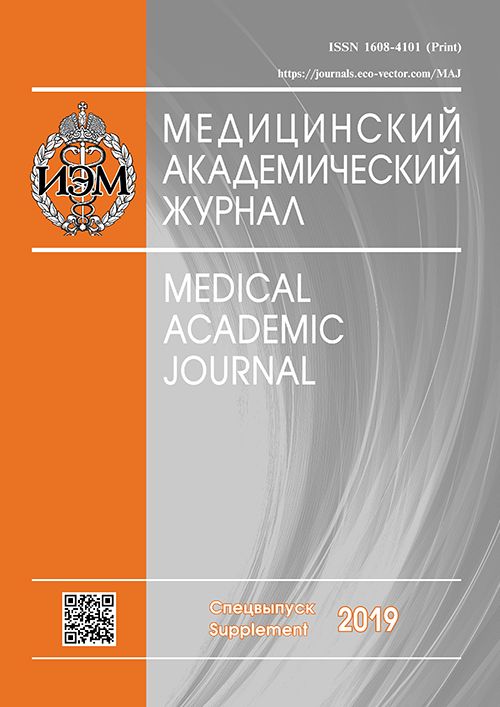THE ROLE OF THE AUTONOMIC NERVOUS SYSTEM IN THE FORMATION OF NEUROENDOCRINE AND IMMUNE DISORDERS DURING STRESS AND DISSTRESSE
- Authors: Pesin YM1, Gabitov VK1, Beisembaev AA1, Potekhina Y.I1
-
Affiliations:
- Kyrgyz-Russian Slavic University, Bishkek
- Issue: Vol 19, No 1S (2019)
- Pages: 31-34
- Section: Articles
- Published: 15.12.2019
- URL: https://journals.eco-vector.com/MAJ/article/view/19310
- ID: 19310
Cite item
Abstract
The aim of the research was studying the features of neurohumoral regulation of carbohydrate metabolism in experimental diabetes mellitus. A model of diabetes mellitus was created by introducing 0.1% solution of epinephrine hydrochloride into animals. Biochemical parameters of carbohydrate metabolism (cortisol, C-peptide and glucose) were studied in 17 animals on day 0, 15, 21, 30, 45. On the same day morphofunctional changes formed in the pancreas and Nodi lymphatici pancreaticoduodenales were studied. With stress, there is an increase in cortisol and C-peptide and a decrease in the concentration of glucose in the blood. In distress cortisol secretion is reduced, and the production of C-peptide and glucose concentration in the blood increases. In the lymph nodes formed functional changes that led to a violation of cellular and humoral immunity in the body. Conclusion. The cause of diabetes is a failure in the work of self-regulating mechanisms of carbohydrate metabolism, which leads to dysregulation pathology of the autonomic nervous system, manifested by antagonism between adrenaline and cortisol, insulin and cortisol.
Keywords
Full Text
About the authors
Y M Pesin
Kyrgyz-Russian Slavic University, Bishkek
V K Gabitov
Kyrgyz-Russian Slavic University, Bishkek
A A Beisembaev
Kyrgyz-Russian Slavic University, Bishkek
Ya I Potekhina
Kyrgyz-Russian Slavic University, Bishkek
References
- Вейн А.М., Соловьева А.Д., Колосова О.А. Вегето-сосудистая дистония. - М.: Медицина, 1981. - 318 с. [Wayne AM, Solov’eva AD, Kolosova OA. Vegeto-vascular dystonia. Moscow: Medicine; 1981. 318 p. (In Russ.)]
- Акмаев И.Г. Нейроиммуноэндокринные взаимодействия: экспериментальные и клинические аспекты // Сахарный диабет, 2002. - № 1. - С. 2-10. [Akmaev IG. Neuroimmune-endocrine interactions: experimental and clinical aspects. Diabetes. 2002;1:2-10. (In Russ.)]
- Страчунский Л.С., Козлов С.Н. Глюкокортикоидные препараты: методическое пособие. - Смоленск: Изд-во СГМА, 1997. - 30 с. [Strachunsky LS, Kozlov SN. Glucocorticoid drugs: a methodological guide. Smolensk: Publishing House of the SSMA; 1997. 30 p. (In Russ.)]
- Cowie CC, Rust KF, Byrd-Holt DD, et al. Prevalence of diabetes and impaired fasting glucose in adults in the U.S. population: National Health and Nutrition Examination Survey 1999-2002. Diabetes Care. 2006;29(6):1263-1268.
- Коненков В.И., Бородин Ю.И., Любарский М.С. Лимфология. - Изд. дом. «Манускрипт». - 2012. - 1103 с. [Konenkov VI, Borodin YuI, Lyubarsky MS. Lymphology. Ed. house. Manuscript; 2012. 1103 p. (In Russ.)]
- Песин Я.М., Бгатова Н.П. Способ моделирования хронической гипергликемии // Патент Кыргызской Республики № 1537 от 29 марта 2013 г. [Pesin YaM, Bgatova NP. Method of modeling chronic hyperglycemia. Patent of the Kyrgyz Republic. No. 1537 dated March 29, 2013. (In Russ.)]
- Европейская Конвенция о защите позвоночных животных, используемых для экспериментов или в иных научных целях. - Страсбург, 18 марта 1986. ETS N 123. [European Convention for the Protection of Vertebrate Animals used for experiments or for other scientific purposes. Strasbourg, March 18, 1986. ETS N 123. (In Russ.)]
Supplementary files







